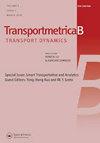城市轨道交通系统列车调度与短时转向策略的鲁棒协同优化
IF 3.4
2区 工程技术
Q2 TRANSPORTATION
引用次数: 2
摘要
本文章由计算机程序翻译,如有差异,请以英文原文为准。
Robust collaborative optimization for train timetabling and short-turning strategy in urban rail transit systems
This paper investigates the robust collaborative train timetabling optimization problem by integrating short-turning strategy and train circulation plan while considering the uncertainty in passenger demand. The passenger dynamics equations are proposed to represent the relationship among headways, short-turning services, and passenger load. A mixed-integer nonlinear programming (MINLP) model is constructed to balance train utilization and stranded passengers. The extra variables are introduced to linearize the nonlinear constraints and convert the original model into a robust counterpart model according to the strong duality theory. Finally, two numerical experiments are carried out to verify the validity of the train timetabling model integrating with short-turning strategies. The study shows that the proposed strategy can better support the balance between stranded passengers and train utilization compared to other regular strategies. Moreover, the results indicate that robust strategies perform well in the trade-off between the optimality and the level of conservatism of the solutions.
求助全文
通过发布文献求助,成功后即可免费获取论文全文。
去求助
来源期刊

Transportmetrica B-Transport Dynamics
TRANSPORTATION SCIENCE & TECHNOLOGY-
CiteScore
5.00
自引率
21.40%
发文量
53
期刊介绍:
Transportmetrica B is an international journal that aims to bring together contributions of advanced research in understanding and practical experience in handling the dynamic aspects of transport systems and behavior, and hence the sub-title is set as “Transport Dynamics”.
Transport dynamics can be considered from various scales and scopes ranging from dynamics in traffic flow, travel behavior (e.g. learning process), logistics, transport policy, to traffic control. Thus, the journal welcomes research papers that address transport dynamics from a broad perspective, ranging from theoretical studies to empirical analysis of transport systems or behavior based on actual data.
The scope of Transportmetrica B includes, but is not limited to, the following: dynamic traffic assignment, dynamic transit assignment, dynamic activity-based modeling, applications of system dynamics in transport planning, logistics planning and optimization, traffic flow analysis, dynamic programming in transport modeling and optimization, traffic control, land-use and transport dynamics, day-to-day learning process (model and behavioral studies), time-series analysis of transport data and demand, traffic emission modeling, time-dependent transport policy analysis, transportation network reliability and vulnerability, simulation of traffic system and travel behavior, longitudinal analysis of traveler behavior, etc.
 求助内容:
求助内容: 应助结果提醒方式:
应助结果提醒方式:


